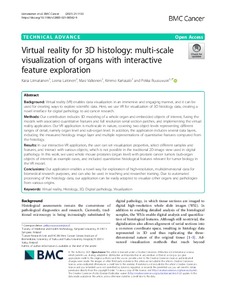Virtual reality for 3D histology: multi-scale visualization of organs with interactive feature exploration
Liimatainen Kaisa; Latonen Leena; Valkonen Masi; Kartasalo Kimmo; Ruusuvuori Pekka
https://urn.fi/URN:NBN:fi-fe2022012711021
Tiivistelmä
Background
Virtual reality (VR) enables data visualization in an immersive and engaging manner, and it can be used for creating ways to explore scientific data. Here, we use VR for visualization of 3D histology data, creating a novel interface for digital pathology to aid cancer research.
Methods
Our contribution includes 3D modeling of a whole organ and embedded objects of interest, fusing the models with associated quantitative features and full resolution serial section patches, and implementing the virtual reality application. Our VR application is multi-scale in nature, covering two object levels representing different ranges of detail, namely organ level and sub-organ level. In addition, the application includes several data layers, including the measured histology image layer and multiple representations of quantitative features computed from the histology.
Results
In our interactive VR application, the user can set visualization properties, select different samples and features, and interact with various objects, which is not possible in the traditional 2D-image view used in digital pathology. In this work, we used whole mouse prostates (organ level) with prostate cancer tumors (sub-organ objects of interest) as example cases, and included quantitative histological features relevant for tumor biology in the VR model.
Conclusions
Our application enables a novel way for exploration of high-resolution, multidimensional data for biomedical research purposes, and can also be used in teaching and researcher training. Due to automated processing of the histology data, our application can be easily adopted to visualize other organs and pathologies from various origins.
Kokoelmat
- Rinnakkaistallenteet [27094]
